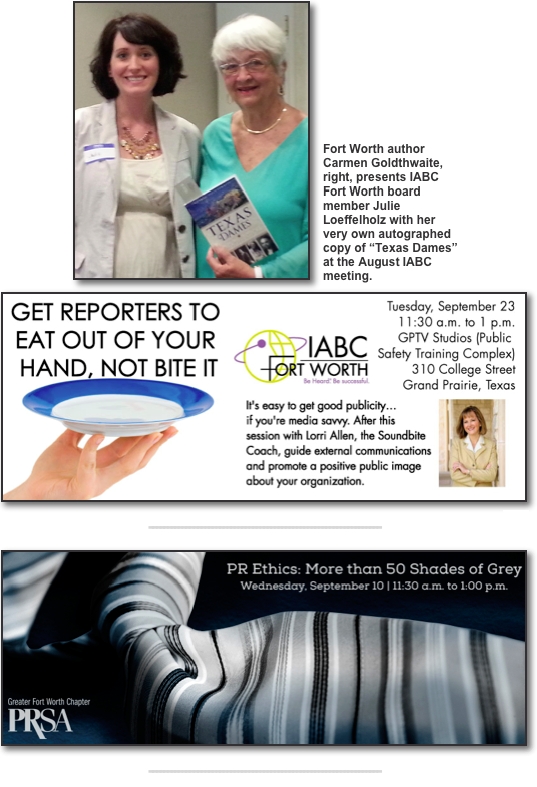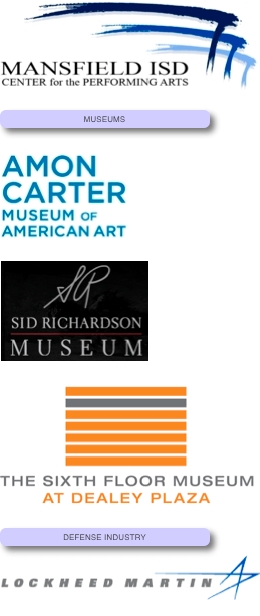PRSA local update V: Explore “The Shifting Nature of Content Marketing” Wednesday, Oct. 8, in a half-day seminar with award-winning communications
consultant/blogger Arik Hanson. Discussion will center around trends and tools, which companies are winning
with content marketing, and hands-on exercises that generate real ideas you can
use back at the office that afternoon. Watch for details.
PRSA local update VI: Chapter president-elect Michelle Clark is looking for volunteers to serve on committees or, better yet, to lead one.
E- her at
michelle.clark@global-prairie.com.
PRSA local update VII: The early registration deadline is fast approaching for the 2014 Southwest District Conference at the Hilton Downtown Baton Rouge Capitol Center, Oct. 29-30, with an optional
excursion to New Orleans on Oct. 31. Registration is $299 for PRSA members,
$399 nonmembers, with a $50 discount through Sept. 29. Among other highlights,
keynoter Devin Lemoine, president of the leadership development company Success Labs, will present “Tales from the Crypt: Secrets to Managing a Successful Career & Being a HiPo,” or how to get tagged as “high potential” in an organization.
PRSA local update VIII: Tony Pederson, the Belo Distinguished Chair in Journalism at Southern Methodist University,
will present "Ethics of Convergent Media" at the PRSA Dallas monthly luncheon
Thursday, Sept. 11, at Seasons 52 at NorthPark Center. Info here.
-----
THIS MONTH IN PR/MARKETING HISTORY BY JEFF RODRIGUEZ
An irreverent look at the people and events that keep us up at night
Goal-line Stand
Striking Football Players Had Strong Defense but Couldn’t Score
Pro football is as much a contract game as a contact game, and that became
acutely obvious in September 1982 when the players went on strike. For eight
weeks they battled the owners in the trenches, seeking to gain the upper hand
in negotiations — and with the public.
The players wanted 55 percent of the league’s gross revenues, which had just gotten grosser with a three-network TV deal
worth $14 million per team per year, more than double the previous annual
payout. The owners had their own expenses to worry about, like paying for their
private jets, and said no.
Players rep Gene Upshaw, a former All-Pro lineman large enough to use two smart cars as roller skates,
vowed “no practices, workouts or trainings, and no games ... until management abandons
its unlawful course and engages in good faith bargaining." The Chicago Bears
countered that a canceled season would cost the team more than $18 million in
lost income — before beer sales. But the players had much at stake: They had no strike fund
to draw on, and, to show they were serious, they had forfeited that year’s pension payments. The average player then made about $6,000 a week, not the
serious dough of, say, a Texas high school football coach, but not an amount to
casually forfeit.
Dallas Cowboys star Tony Dorsett said he “had enough money stashed around the country that I can go as long as they want
to go.” Other seasoned players were more concerned for you, little buddy. “These rookies haven’t had a chance at the big money,” one veteran said, “so they haven’t gone into debt.”
The players association needed PR, so it organized two not-really games between
players from the National Football Conference and the American Football
Conference. Alas, these “all-star” scraps, in Washington, D.C., and the next day in Los Angeles, featured few
actual stars and couldn’t attract 15,000 paying fans, even with TV blackouts and tickets as low as $6.
It didn’t help that Washington’s John Riggins said of his participation, “I guess I'll do just about anything for money.”
The strike plodded on for 57 days, ending ignobly Nov. 16 with players revolting
against the union (the owners said they’d been revolting all along) and calling for Upshaw to resign. But a new
agreement did include a severance package for retiring players, a salary hike
and bonuses based on experience.
The sides tried to salvage the season. They played nine games, followed by a
"Super Bowl Derby" involving the top eight teams. The Cowboys advanced to the
NFC championship game and were punished by the Redskins, who went on to win the
consolation ’Bowl. Fun fact: Troy Aikman was 16 years old.
Still hanging were revenue and free agency issues. When the agreement ended in
1987, the players struck again, washing out three weeks and resulting in the
infamous “scab” games, featuring hastily organized teams of replacement players. But that’s a PR headache for another day.
A work stoppage in athletics resembles a strike in any other industry in one big
way. The workers are depicted as villains. The players association made “demands” (Time magazine, Wikipedia, fan website), management made “offers.” The phenomenon occurred again in 2012, when NFL referees struck. Anyone
remember what they wanted? The union said its request would cost the owners an
additional four-hundreths of 1 percent of league revenue. But the greedy
referees took the blame.
Finally, once the media voices were done taking sides in the 1982 dispute, the
teams resumed courting the fans. Not to worry: In 1983 the NFL recorded its
second-highest total attendance, and in ’84 a national poll proclaimed that football had eclipsed baseball as the most
beloved spectator sport in the land.
So which side won the 1982 strike? Given that football appears to be more
popular than motherhood, perhaps the answer is: both.






